As the leaves begin to turn and autumn sets in, many of us turn to thoughts of the deities. Autumn is a really important time in pagan culture between Scorpio season and the harvest, and there are plenty of autumn gods and goddesses to work with or worship, depending on your practice.
During the autumn equinox, summer officially ends and fall begins. Mabon, or the Autumn Equinox, is the time when day and night hours are equal. In the coming months, the days will get shorter and the nights will get longer.
Many aspects of this wonderful season have been linked to human life by ancient civilizations, astrology, and science. We can use these symbolic meanings to remind ourselves of Mother Nature’s powerful influence on our lives. The Winter Solstice, the Spring Equinox, the Summer Solstice, and the Autumn Equinox are all significant seasonal transition points for indigenous people from around the world.
And autumn itself is ripe with metaphors, typically about the descent into the Underworld, the dark period, etc. to eventually be reborn in spring.
This season is full of magic, and there are many autumn gods and goddesses who embody its transformational energy. Here are some of the top autumn gods and goddesses from various pagan cultures.
Before we really dive into the gods and goddesses of autumn, I want to go over a few symbols of autumn.
Symbols Of Autumn:

Autumn is a time of endings, of death, and of the destruction that must occur for winter to eventually usher in spring. It’s a time of transition and is metaphorically hard but necessary. But it’s also a time of abundance as the harvest commences and food is preserved for the winter.
Dying Leaves:
The significance of death during autumn is clear. Similar to the symbolism of the Ouroboros, autumn is a time when things must die to be reborn. When the leaves the crunchy and the trees go into hibernation (symbolic of the Underworld), we must know that spring will come again and the tree will be reborn with new leaves. This is symbolic of baptism or initiation happening in the physical world around us.
Baskets:
Yet autumn is also a time of abundance. The woven baskets we use show us how something dead (sticks, twigs, branches) can still be used, and how all things are a part of the circle of life. And of course, the basket represents the abundance of the harvest at the end of the season. The plants must die to sustain us through the winter. All energy must be in balance: some things must die (the plants) so that others (us as humans) can live.
The Apple:
I talk about the symbol of the apple a lot on my Patreon because it just has so much meaning. From the garden of Eden to the modern-day computer, the Apple symbolism is everywhere. But I find it interesting that apples are picked in the fall. While the apple can be the poison apple, such as in Snow White, sending us to the metaphorical Underworld of winter with just one bite, it also represents something that can sustain us through the winter. It is the knowledge that allows us to grow should we be strong enough to overcome the poison.
Pumpkins:
Obviously, pumpkins are huge symbols of both autumn and specifically Halloween (Samhain). Originally, pumpkins were carved to be used as tricksters, to keep the spirits and other entities on Halloween night from stealing souls. But pumpkins (again) also represent the harvest and the bounty that can sustain through the winter.
Cornucopia:
Also known as the Horn of Plenty, the cornucopia is a symbol of abundance and plenty. It is often depicted as a horn overflowing with fruits, vegetables, and other bountiful items, representing the harvest and the blessings of autumn. As a sacred symbol in many cultures, the horn of plenty can represent the blessings of nature.
Gods & Goddesses Of Autumn:

Here are the top gods and goddesses of autumn, at least in my book. Transformational gods and goddesses are much too numerous to include in one blog post! However, I think that these autumn gods and goddesses all represent clear transformational qualities through death and rebirth.
Many of these autumn gods and goddesses also relate to the harvest, to abundance, to preservation, and to preparation for the dark winter ahead. Therefore, you’ll also find some gods and goddesses of Samhain on this list.
1. Demeter, Greek Goddess of the Harvest
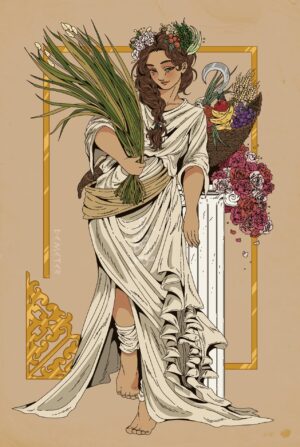
Demeter is the goddess of agriculture and fertility. She is often portrayed with a sheaf of wheat or a cornucopia, symbols of abundance. In autumn, we give thanks for her bounty and celebrate her many blessings.
During the fall and winter months, Demeter is sometimes known as the dark mother because she mourns the loss of her daughter, Persephone, to the Underworld. Yet pagans also celebrate the last harvest as a time when Demeter allows the bounty to be reaped from the earth in preparation for winter.
According to Greek mythology, Demeter, also known as Ceres in Rome (hence the word cereal), taught humanity how to cultivate, preserve, and cook grain and maize. Her role was to rule over the fertility of the land as one of the main deities of the harvest. So in some ways, Demeter is the goddess of the seasons; she helps to usher in the new season and allows all things to come in cycles. She is a reminder that we must face the dark times of winter to be reborn in spring.
Because Demeter is so predominantly featured in the Eleusinian Mysteries from Ancient Greece, she is not only a deity of the harvest but also a symbol of initiation. Her daughter’s descent into the Underworld and rebirth is symbolic of the initiate’s journey to self-enlightenment.
To learn more about initiatory practices and the mysteries, head to the Patreon.
2. Dagon, Semitic God Of Agriculture
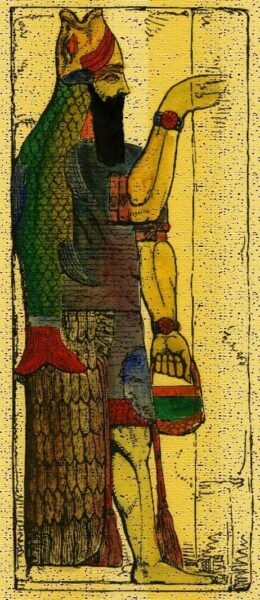
Dagon was the god of fertility and agriculture worshipped by the Amorites, an early Semitic tribe. Dagan was the Hebrew and Ugaritic common noun for “grain,” and was one of the primary autumn gods to allow a bountiful harvest. Early Sumerian texts mention him as a father-deity and sometimes as a fish god. Amorites attribute the invention of the plow to Dagon. Typically, thanks for abundance are focused on Dagon; he is less of a transitional god and more of a god who “rests” until fertility is restored in the spring.
3. Kerridwen, Celtic Goddess Of Wisdom
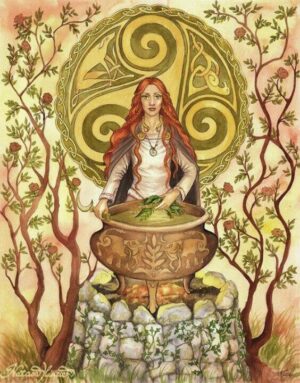
Kerridwin is a Welsh Triple Goddess. Cauldrons were Celtic symbols of prosperity and rebirth, and she herself was the Mother Goddess, known for nurturing her children. A white sow is Kerridwin’s totem animal (a symbol of death) as well as her crone/transformatrix aspect.
The witchy figure of Goddess Kerridwen, Keeper of the Cauldron, is closely associated with Samhain and Halloween at the end of autumn. As she stirs the cauldron of rebirth, knowledge, and transformation, she transforms the world. Out of darkness, she reminds us, comes new life and new ideas. Kerridwen, who is a witchy goddess capable of crossing worlds, also reminds us to remember and honor our dear departed.
4. Mercury, Roman God Of Commerce
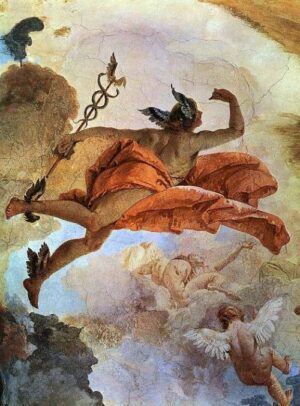
Mercury was known as a messenger of the gods, but he was particularly associated with the grain trade and was a god of commerce. He ran from place to place in late summer and early fall to let people know harvest time was coming. In Gaul, he was also regarded as a god of prosperity in agriculture and commerce.
Also known as Hermes in Greek mythology, Mercury is the god of shopkeepers and merchants, travelers and transporters of goods, and thieves and tricksters. He represents all things changing and all things earthly, including the money and bounty required to make it through the winter.
5. Pachamama, Incan Goddess Of Fertility, Time, & The Earth
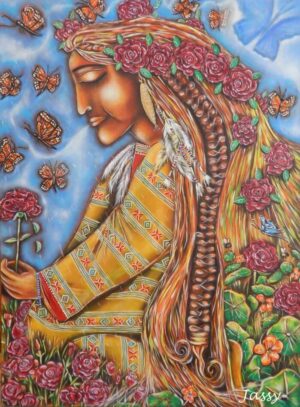
The fertility goddess Pachamama is also known as the mother of time and the earth. Her responsibilities include planting and harvesting crops, as well as mountains and earthquakes. Life is sustained by her. The myth tells that if you don’t respect the earth, Pachamama will become a dragon beneath the mountains, causing earthquakes, a reminder to respect her.
6. Hades, Greek God of the Underworld
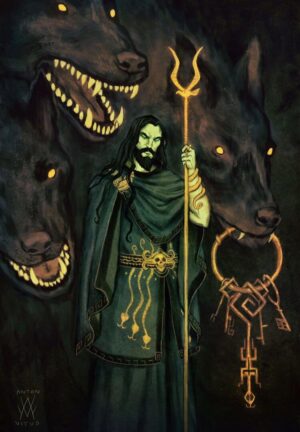
While Hades isn’t technically one of the well-known autumn gods, he always makes me think of the autumn season because his kidnapping and eventual marriage to Persephone is what indirectly brings about the cold weather. As the “unseen” god with his helm of darkness, Hades certainly reminds me of Scorpio season and is even tied to sign of Scorpio through Pluto, his Roman name.
So sure, Hades is a god of the dead literally, but he metaphorically represents death, rebirth, and transformation as well. And isn’t that exactly what we (and all of nature) are doing in the fall? Things must die, or end, in order to be reborn in the spring. We know that spring cannot come without the last harvest and without the cold of winter.
When the nights get longer, it’s a time to turn inward, to our own Underworld, and a period of reflection. This period came come through ritual, shadow work, or initiation into the Qliphothic tree. Metaphorically, Persephone must visits Hade in the Underworld during this period of reflection before she can be reborn on the earth each spring.
7. Autumnus, the Roman goddess of the Harvest
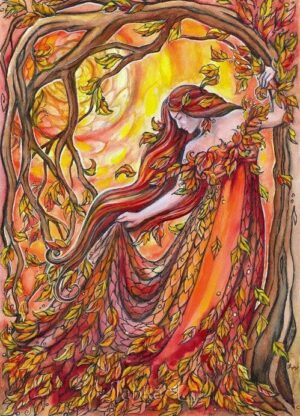
8. Inanna, the Sumerian goddess of fertility and abundance
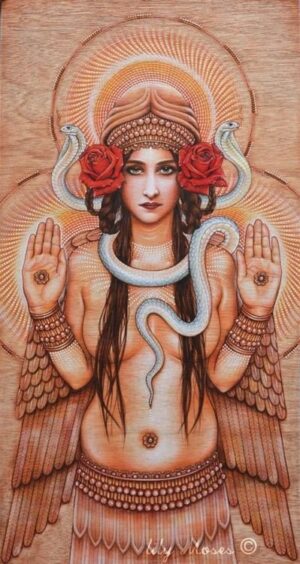
The story of Inanna is another descent into the Underworld (see Demeter). Ereshkigal, her sister, was the ruler of the Underworld. The land became infertile and crops stopped growing when Inanna was in the Underworld, similar to Persephone’s story. Inanna restored fertility to the land after returning to Earth and bringing crops back to life.
Thus, Inanna’s yearly descent into the Underworld marks the final harvest and the beginning of winter. The world and Inanna must both “die” during her descent into the Underworld in order to be reborn anew in the spring. And of course, Inanna’s descent also represents initiation and ultimate illumination of the self.
9. Persephone, Greek Queen of the Underworld
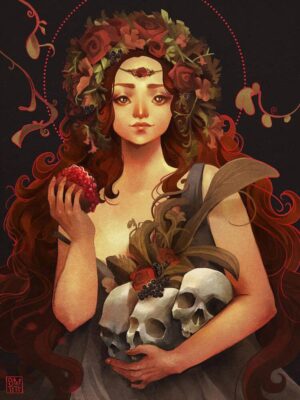
I couldn’t write a post about autumn goddesses without including Persephone. While some revere Persephone as the Greek Goddess of spring, she also has a very important role in the fall, and she is actually one of the primary goddesses of Samhain, the pagan Halloween.
It is her descent to the Underworld that brings about the cold weather (via her mother, Demeter). Metaphorically, we all go to the Underworld with Persephone, moving into a time of darkness, scarcity, and reflection. The harvest is our last attempt to store what we need in order to make it through.
While the winter can seem dark and scary, much like the Underworld, it is necessary to face these cold times and to see our demons for what they really are. And after a long hard fight, we are only then able to embrace spring and new life.
More than any other Greek goddess, Persephone embodies transformation. One must metaphorically die (like the leaves and plants in the fall) to be reborn. This is why Persephone is used as the ultimate symbol of transformation and illumination in the Ancient Greek mysteries.
Read more about Persephone’s myth and transformation here.
10. Dionysus/Bacchus, The Greek/Roman God Of Wine

Bacchus, known as Dionysus in Greek mythology, is the god of wine, vineyards, and celebration. The grape harvest takes place during autumn, making Bacchus/Dionysus a deity associated with the festivities and the intoxicating essence of the season.
On a literal level, Dionysus is strongly associated with the cultivation of grapes and wine production. Autumn is the time of year when grapes are harvested in many wine-producing regions. As the god of wine, Dionysus can be indirectly linked to autumn through the grape harvest and the subsequent festivities and celebrations associated with winemaking during this season.
In ancient Greece, Dionysus was honored during various harvest festivals and celebrations, such as the Anthesteria and the Rural Dionysia. These festivals often took place in the autumn months and involved rituals, theater performances, and the consumption of wine. Thus, Dionysus’ association with these autumnal celebrations further ties him to the spirit of the season.
But Dionysus is often also associated with transformation and the cycles of life. Autumn is a time of transition, when nature undergoes visible changes—leaves falling, plants withering, and the landscape preparing for winter. This sense of transformation aligns with Dionysus’ role as a deity associated with the cyclical nature of life, death, and rebirth.
Dionysus’ traits and attributes can be metaphorically linked to certain aspects of autumn. For example, his wild and ecstatic nature may evoke the sense of abandon and liberation associated with the changing colors of autumn foliage. Additionally, the intoxicating effects of wine, which Dionysus represents, can be seen as a metaphor for the rich and vibrant hues of autumn.
11. Freyja, Norse Goddess Of Love, Beauty, & Fertility
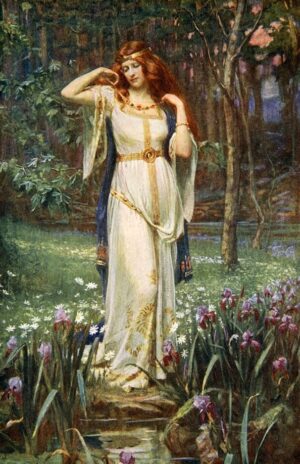
Freyja, the Norse goddess of love, beauty, and fertility, is not directly associated with autumn in Norse mythology. However, there are a few reasons why she can be connected to this season
In Norse mythology, Freyja is associated with the beauty and abundance of nature. The falling leaves and the vibrant colors of autumn can be seen as an expression of this natural beauty, aligning with Freyja’s domain.
Additionally, Freyja is a goddess of fertility and abundance. Autumn is a season of harvest, when crops are gathered and the fruits of the earth are collected. Freyja’s associations with fertility and prosperity can be symbolically linked to the abundance of the autumn harvest.
Autumn represents a period of transition, as the world shifts from the warmth and growth of summer to the colder, dormant months of winter. Freyja, as a goddess of love and beauty, can be connected to the concept of transformation and change that autumn brings.
Lastly, Freyja is a member of the Vanir, one of the two groups of gods in Norse mythology. The Vanir are often associated with fertility, nature, and prosperity. These themes can be associated with the autumn season, as it is a time of reaping the rewards of the earth’s fertility and celebrating the harvest.
Ways To Celebrate The Autumn Season:
Whether you want to honor the autumn goddesses/gods or simply celebrate the energy of autumn in an appropriate way, these ideas should serve you.
Go Walking
Enjoy nature’s wild abundance by walking in the wild. Among the fruits and nuts you may find are damsons, sloes, elderberries, blackberries, apples, nuts, and fallen leaves. Whether at home or out in nature, you can create an autumnal altar with your autumn treasures.
Clear Out The Home
As autumn approaches, it’s a great time to finish up unfinished projects and get rid of unwanted items. The winter months can then be spent hibernating and reflecting in a calm and restful sanctuary. Autumn is the perfect time to get rid of everything you don’t need and then stock up on items that will sustain you through the winter. You must destroy to create, and this is what the fall season is all about.
Create an Autumnal Altar
Harvest and autumn altar items may include mini pumpkins, squashes, apples, leaves, acorns, conkers and hazelnuts – seeds represent strength. The nuts of our native trees – walnuts, hazelnuts, conkers – are full of potential and carry the qualities of their mother trees.
You can also include:
-Candles in orange, reds, purples, blacks, and browns to symbolize the harvest season.
-Cauldrons or chalices are closely associated with Samhain. Symbolizing life, death, transformation, and rebirth, a cauldron represents the divine feminine.
-A photograph or a memento of an ancestor or friend who has passed away.
-Crystals symbolic of transformation
-Symbols of the Underworld such as statues of dogs, owls, or skulls
This can be an altar simply for fall, or you can create an altar specific to the gods of Samhain that you choose to work with during the month of October.
Candle Ceremony for Honouring Ancestors
It isn’t only the gods and goddesses of Samhain and autumn that we worship during the fall. Ancestors can be honored at this time with candle ceremonies, alone or with loved ones. This is a long-standing tradition that can be really comforting. However, you can also use this ceremony to incorporate the energy of your ancestors into yourself to emulate the best parts of your ancestors in your daily life and to draw strength from your bloodlines.
A Harvest Festival
Bring loved ones together and decorate your dining table with colorful autumn leaves, vegetables, and nuts. Celebrate autumn by enjoying harvested fruits and vegetables. Hot blackberry crumble, roasted root vegetables with herbs, and pumpkin soup are all great winter warmers. As a thank you for all the bounty of autumn, leave out an offering of wine or grape juice.
Initiation
Lastly, the fall is the perfect time for initiation into the metaphorical Underworld, the mysteries, or the Qliphoth. This is why I believe that the goddesses and gods of Samhain (and the harvest time) are so important. They represent a metaphorical death of the self (and of illusions) and rebirth through illumination.
If you find yourself on the path of occult work, then I recommend that you consider initiation into the darker side of the path during the autumn months, specifically during Scorpio season. But as always, make sure that your mind is strong enough to withstand the turmoil before initiation. See more about initiation on my Patreon here.


